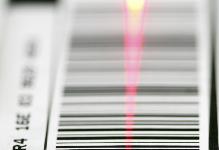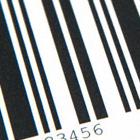 | |||||
 | |||||
| ||
 | |||||
 | |||||
There are a number of different barcode symbologies used within the retail industry. The ones most frequently encountered are: EAN-13, EAN-8, UPC-A, UPC-E, ITF-14, ISSN, ISBN and GS1-128. Different symbologies will be used depending on the barcode application, packaging level and space available.
There are also many barcode symbologies in use whose main purpose are for the Non-Retail market e.g. internal stock control. For more information on these including 2-D symbologies click here.
This range of barcode symbologies are used for retail Point of Sale (POS), and is the symbology you will see on products such as chocolate bars and crisp packets. The magnification factor usually ranges from 80-120% and the human readables are generally displayed underneath the code with optional light margin indicators.
The EAN-13 is a 13 digit number, made up of a country code plus company prefix, your own allocated digits and a check digit. The EAN-8 is a smaller version of the EAN-13 for very small products and for in-house codes for own brands, the UPC-A and UPC-E are the North American equivalents of the EAN-13 and EAN-8 respectively and should be used if the product is intended for sale also in the USA or Canada as they are accepted worldwide.
To create an EAN/UPC barcode you will need to have a number allocated to you by your country's governing body .
For further details on the EAN/UPC range including ordering information for the Axicon bureau, Download EAN.
ISSN/ISBN
The ISBN and ISSN barcodes are used on books and magazines respectively. The barcodes are actually EAN-13 codes, but the numbering system used to generate the barcode is different.
The ISBN and ISSN numbers are regulated by two separate organisations. For further details on the ISBN/ISSN range including ordering information for the Axicon bureau, download the Download ISBN, and Download ISSN.
ITF-14
The Interleaved Two of Five barcode is a large barcode symbol which is mainly used on outer packaging (Traded unit packs). The simpler structure of the bars and spaces make it more appropriate for use on poorer surfaces such as corrugated card, and is used to display the 14 digit number gained from the article number.
The ITF-14 symbology can be produced at any magnification from 50% (for labels, 62.5% for corrugated card) up to 100%, with optional bearer bars.
For further details on the ITF-14 range including ordering information for the Axicon bureau, Download ITF.
GS1-128
The GS1-128 barcode symbology was introduced in response for the requirement to encode supplementary information (e.g. dates, weights etc) and generally also includes the product code. Application Identifiers (AI's) are available for a wide range of supplementary data which the user may want to encode. Some data fields are fixed length, others variable, some numeric only whilst others are alphanumeric. The user can express multiple pieces of data either as separate barcodes or concatenated into a single barcode (subject to overall length restrictions. The GS1-128 symbology is particularly used in the retail industry for outer packaging of goods with a shelf life of less than 42 days, with the best before date A.I. (15), and is the only symbology recommended to show variable measure in traded units. GS1-128 is also used to show the 18 digit Serial Shipping Container Code (SSCC) number which is allocated to uniquely identify a shipment, for example, of pallets or boxes (which could contain a mix of products).
Barcode specifications must be adhered to and can be obtained from:
GS1: www.gs1uk.org
Aim: www.aimglobal.org
BSi: www.bsi-global.com